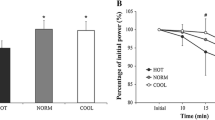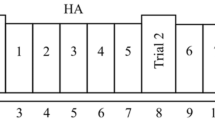Abstract
The response of core temperature to exercise was investigated during recovery in order to avoid the antagonistic competition between exercise and thermal reflexes for the same effector systems which control skin blood flow. Five healthy, non-training males [mean (SD) age, 23.8 (2.04) years] were habituated to 29° C at relative 50% humidity for more than 2 h and then exercised by treadmill running at about 75% maximum oxygen uptake for 18 min. They then remained at 29° C for up to 65 min of recovery. Oesophageal (T es), rectal (T re) and skin temperatures (T sk) were recorded at 5-s intervals throughout. The abrupt fall of temperature gradient from the forearm to finger was used to identify the T es for skin vessel dilatation (T dil) during exercise. Mean (SE) Ts rose from a resting value of 36.67 (0.15)° C to 38.22 (0.24)° C, mean T re rose from 37.09 (0.25)° C to 38.23 (0.15)° C, and T dil occurred at 37.39 (0.32)° C. Within 10 min of recovery mean T es fell to 37.31 (0.24)° C, where it remained a significant 0.64° C above its pre-exercise (PrEx) level (P≤0.018) but insignificantly different from T dil for the remaining 55 min of recovery. Meanwhile, T re fell gradually throughout recovery to 37.64 (0.18)° C. The T sk at all non-acral sites except the thigh had recovered to PrEx levels by 20–30 min post-exercise (PoEx). The rapid PoEx fall of T es to the level of T dil and the subsequent plateau above PrEx values suggests that heat dissipation during recovery was primarily passive once T es had fallen to T dil, even though T es and T re were significantly elevated. The relationship of these results to the set-point and load error concepts of thermal control is discussed.
Similar content being viewed by others
References
Astrand I (1960) Aerobic work capacity in men and women with special reference to age. Acta Physiol Scand 49[Suppl 169]:67
Benedict FG, Parmenter HS (1929) Human skin temperature as affected by muscular activity, exposure to cold, and wind movement. Am J Physiol 55:1916–1923
Bishop JW, Donald KW, Taylor SH, Wormald PM (1961) The blood flow in the human arm during leg exercise. Circ Res 9:264–274
Bothorel B, Galeou M, Dewasmes G, Hoeft A, Candas V (1991) Leg skin temperature and thigh sweat output: possible central influence of local thermal inputs. Eur J Appl Physiol 62:405–409
Briese E, Cabanac M (1990) Stress hyperthermia: physiological arguments that it is fever. Physiol Behav 49:1153–1157
Cable NT, Green JH (1990) The influence of bicycle exercise, with or without hand immersion in cold water, on forearm sweating in young and middle-aged women. Exp Physiol 75:505–514
Cooper KE, Cross KW, Greenfield ADM, Hamilton DMCK, Scarborough H (1949) A comparison of methods for gauging the blood flow through the hand. Clin Sci 8:217–234
Felder D, Russ E, Montgomery H, Horwitz O (1954) Relationship in the toe of skin surface temperature to mean blood flow measured with a plethysmograph. Clin Sci 13:251–256
Fox RH, Goldsmith R, Kidd DJ, Lewis HE (1963) Blood flow and other thermoregulatory changes with acclimatization to heat. J Physiol (Lond) 166:548–562
Gaskell P (1956) Are there sympathetic vasodilator nerves to the vessels of the hands? J Physiol (Lond) 131:647–656
Greenfield ADM (1963) The circulation through the skin. In: Handbook of physiology, circulation, sect 2, chapt 39, vol 11, Am Physiol Soc, Washington D.C., pp 1325–1351
Hirai A, Tanabe M, Shide O (1990) Enhancement of finger blood flow response of postprandial human subjects to the increase in body temperature during exercise. Eur J Appl Physiol 62:221–227
Hirata K, Nagasaka T, Hirai A, Hirashita MZ, Takahata T (1983) Peripheral vascular tone during heat load is modified by exercise intensity. Eur J Appl Physiol 51:7–15
Hori T (1991) An update on thermosensitive neurons in the brain: from cellular biology to thermal and non-thermal homeostatic functions. Jpn J Physiol 41:1–22
Horowitz M (1990) Thermoregulation under conditions of impaired body fluid/osmotic balance in mammals. J Basic Clin Physiol Pharmacol 1:267–276
Jackson DC, Hammel HT (1963) Hypothalamic “set” temperature decrease in exercising dog. Life Sci 2:554–563
Johnson JM (1992) Exercise and cutaneous circulation. Exerc Sports Sci Rev 20:59–97
Johnson JM, Park MK (1982) Effect of heat stress on cutaneous vascular responses to the initiation of exercise. J Appl Physiol 53:744–749
Johnson JM, Rowell LB, Brengelmann GL (1974) Modification of the skin blood flow — body temperature relationship by upright exercise. J Appl Physiol 37:880–886
Kaciuba-Uscilko H, Kruk B, Szczyaczewska M, Opaszowski B, Stupnicka E, Bicz B, Nazar K (1992) Metabolic, body temperature and hormonal responses to repeated periods of prolonged cycle ergometer exercise in men. Eur J Appl Physiol 64:26–31
Kellog DJ Jr, Johnson JM, Kosiba WA (1991) Control of internal temperature threshold for active cutaneous vasodilation by dynamic exercise. J Appl Physiol 71:2476–2482
Kenney NL, Johnson JM (1992) Control of skin blood flow during exercise. Med Sci Sports Exerc 24:303–312
Kranning KK II, Gonzalez RR (1991) Physiological consequences of intermittent exercise during compensable and uncompensable heat stress. J Appl Physiol 71:2138–2145
Mekjavic IB, Sundberg CJ, Linnarsson D (1991) Core temperature “null zone”. J Appl Physiol 71:1289–1295
Nadel ER, Pandolf KB, Roberts MF, Stolwijk JAJ (1974) Mechanisms of thermal acclimation to exercise and heat. J Appl Physiol 37:515–520
Nielsen M (1938) Die Regulation der Körpertemperatur bei Muskelarbeit. Skand Arch Physiol 79:193–230
Nielsen B (1966) Regulation of body temperature and heat dissipation at different levels of energy and heat production in man. Acta Physiol Scand 68:215–227
Rubenstein EH, Sessler DI (1990) Skin-surface temperature gradients correlate with fingertip blood flow in humans. Anesthesiology 73:541–545
Savard GK, Nielsen B, Laszczynska J, Larsen BE, Saltin B (1988) Muscle blood flow is not reduced in humans during moderate exercise and heat stress. J Appl Physiol 64:649–657
Sawka MN, Wenger CB (1988) Physiological responses to acute exercise-heat stress. In: Pandolf KB, Sawka MN, Gonzalez RR (eds) Human performance physiology and environmental medicine at terrestrial extremes. Benchmark, Indianapolis, pp 97–152
Tam HS, Darling RC, Chek HY, Downey JA (1978) Sweating response: a means of evaluating set-point theory during exercise. J Appl Physiol 45:1546–1552
Taylor WF, Johnson JM, O'Leary D, Park MK (1984) Effect of high local temperature on reflex cutaneous circulation. J Appl Physiol 57:191–196
Webb P, Nagle FJ, Wanta DM (1991) Heat regulation during exercise with controlled cooling. Eur J Appl Physiol 62:193–197
Zeisberger E (1990) Central modulators of thermoregulation. J Basic Clin Physiol Pharmacol 1:277–289
Author information
Authors and Affiliations
Additional information
These data have been presented at the Canadian Physiological Society Winter meeting, January 1993, but have not been previously published
Rights and permissions
About this article
Cite this article
Thoden, J., Kenny, G., Reardon, F. et al. Disturbance of thermal homeostasis during post-exercise hyperthermia. Europ. J. Appl. Physiol. 68, 170–176 (1994). https://doi.org/10.1007/BF00244031
Accepted:
Issue Date:
DOI: https://doi.org/10.1007/BF00244031




